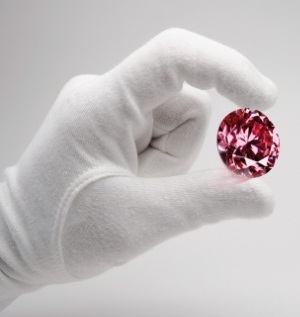The Diamond Investment Promise: Are Diamonds Finally A Commodity?
August 22, 12
By Edahn Golan
"Investment" is the word du jour of the diamond world and investment in diamonds is becoming a common discussion in financial circles. At the same time, a growing number of initiatives are in various stages of formation.
The wide range of formats and ways of going about it reflect that this is a budding endeavor with the initiatives testing new, mostly uncharted, ground.
At the heart of all of the offerings is the expectation that the price of diamonds from one-carat whites to high-end fancies, are set to increase steadily; some will appreciate slowly, beating inflation, while others are expected to appreciate 15 percent annually.
The expectation that the price of diamonds are set to increase stands on two legs – decreasing diamond reserves and increasing demand. The global diamond mining industry produces, on average, about 120-130 million carat of gem and industrial grade diamonds. Of this production, 28 million carats are gem and near gem quality rough diamonds that is fit for the global jewelry industry.
|
|
With the exception of Alrosa – the world’s largest producer by volume – all of the other diamond miners are decreasing production.
At the same time, the established diamond miners and many prospective miners are constantly exploring for new diamond sources. Currently there is no known high quality, high-yield rich diamond source that is not mined. Without any new mines coming online, the global diamond industry is facing an increasing shortage of natural diamonds.
It takes some 10 years from the discovery of a new resource to commercial production of a diamond mine. This means that if a new pipe is found today, it won't be before 2022 when its production will be made available to the market.
In practical terms, there is no expectation that global diamond production will increase in the next ten year – at best.
On the other side of the equation is demand. The leading consumer demand – by price point and growth – is bridal jewelry. In India, bridal jewelry is switching from gold to diamond jewelry, in China diamond wedding rings are spreading from the trend setting Shanghai and Beijing to other urban areas and in the U.S. bridal jewelry continues to be a must have.
GDP per capita, a reliable predictor of diamond jewelry demand, is set to grow, mainly in the BRIC countries –
China and
While GDP growth is expected to slow down in 2012, China and India are expected to continue their above average growth and provide the two economic engines of the diamond industry. Global GDP growth is expected to slow to 2.5 percent in 2012,
Aided by continued marketing efforts, this growth is backing the increased demand in diamond jewelry.
Global consumer demand for diamond jewelry is growing and shifting. If in the past more than 50 percent of global diamond jewelry consumptions was in the U.S., today consumers from growing economies are buying diamond jewelry at increasing levels.
By 2015, China and India, together with Hong Kong, Taiwan and the Gulf countries are expected to consume about 40 percent of diamond jewelry globally, rising from the current 31 percent market share.
Demand for diamond jewelry in China and India increased by an estimated 10 percent and 9 percent respectively in 2010 and by another 9 percent and 8 percent in 2011. This year, the forecast is for continued steady growth, the same as in 2011.
The forecasted rise in consumer demand, taking place when supply will be steady at best and declining in the more likely scenario, is expected to provide the backing to rising diamond prices in the consumer markets and fuel rising prices in years to come.
|
|
The first category is comprised of fancy color diamonds, mainly those with VS clarities and better, preferably with at least a 'Fancy' color grading. Fancy color diamonds that have only one color without a secondary color (pink vs purplish pink, for example) are favored. This category also includes diamonds larger than 10 carats with a DEF color and FL-VVS clarity.
This category is not a new venue for investment. However, with the growing understanding of the potential diamonds have has an investment venue, more are considering it today.
The second category of goods is often referred to as "standard," "ABC" or "bread and butter" goods. Broadly defined, these goods consist of one carat, D-J color, IF-SI1, round GIA certified diamonds. Some companies are looking at a broader range of size, ranging from 0.50 carats to 3 carats.
A Collapse Paves the Road
The event that fueled this swell of projects was the 2008 financial collapse that crushed the value of many investors' savings and the fall of a number of leading financial institutions. In that time, the value of shares on the stock markets dropped, housing and real estate prices declined sharply mired by over-reliance on poorly offered mortgages, commodities traded around the world and used by industry and consumer in a variety of applications fell out of favor and the lost demand brought the prices sharply down. Investors saw the value of their portfolios plummet.
In response, many investors started seeking ways to add to their portfolios a component that will remain stable in times of economic calamity, a venue that at the very least will protect some of the portfolio and remain liquid. The desire is that such a component will provide an option to put cash in the hand of an investor without - or at least hardly without - loss to the value of saved capital.
This of course is the very minimum requirement. Ideally, just as with any other investment, appreciation is desirable.
As prices of colored diamonds at auctions kept grabbing attention, financial institutes and wealth mangers started considering diamonds as the possible missing component they were seeking. Simultaneously, diamond traders realized that the precious gem they have has performed better than most other investments during the financial crisis. Thus, the initial ideas of investing in diamonds started to come alive.
Consequently, it was not long before these two groups, sometimes jointly, started looking for ways to commoditize diamonds, something that happened a few times before, but never to the extent that diamonds have become a bona fide commodity akin to precious metals, wheat and coffee.
Why Now?
The 2008 crash was an unusually deep one, but not the only recession or difficult economic period in recent memory. Other changes are making this point in time attractive to invest in diamonds, specifically, four changes that are taking place in the diamond sector.
First, until recently De Beers was the monopolistic supplier of rough diamonds to the world. Its rough pricing policies had a great influence on polished prices. The firm sought to maintain prices by regulating the availability of rough diamonds. To do so, the company held to a very large stock of rough diamonds of an estimated $5 billion, well above its annual sells. By deciding what to offer and when, it could maintain prices in the market – not completely, but enough to raise worries in the investment community that one player can rather easily effect prices.
|
|
In this process, De Beers also lost its marketing contracts with other large diamond miners, such as Alrosa, giving other firms a stab at rising – or declining prices – as the market demanded.
Today there are a number of large diamonds miners, Alrosa, BHP Billiton and Rio Tinto, as well as several mid-sized companies such as
The second reason is a lack of pricing transparency. Without knowing at how much polished diamonds are sold, an open trading market is not possible. The rise of platforms such as IDEX Online and a number of other such operations are changing this, bringing transparency to the market. Today price discovery of polished diamonds is much easier, allowing traders to have a better understanding at what price a diamond is sold.
Price discovery is a fundamental requirement for investment. Without knowing the price, investors cannot asses and investment or make an informed decision on buying or selling. Great efforts are put by the forming diamond investment entities into providing price information in a transparent and objective way.
A third issue is a need for a marketplace open to the financial community, a place where diamonds can be bought and sold easily and at market prices. This, just like transparent pricing, is now ready and available. Some of the new entities are forming their own platforms where investors will be able to buy and sell diamonds. Others intend to employ a more traditional method, using experienced buyers that will facilitate the transactions.
However, while using a buyer is a good option in many instances, the need is for an automatic platform where buying and selling is quick, efficient and trackable (See details on the Guaranteed Diamond Transactions™ (GDT™) spot market platform for an example of such trading arena).
Finally, because of the afro mentioned three reasons, the investment community was reluctant to enter into diamond investments. With the growing fragmentation of the mining sector, the availability of transparent pricing and creation of a trading platform, these barriers are being removed, creating new opportunities for the financial sector to invest in diamonds.


